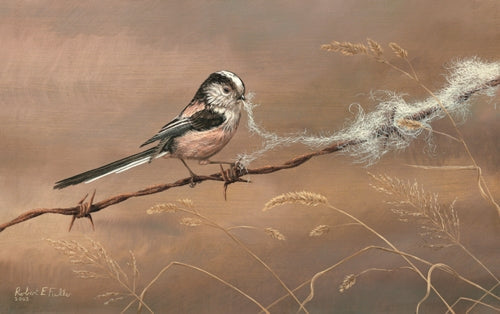 Long-tailed tit | Limited edition print | Shop now
Long-tailed tit | Limited edition print | Shop now
Long-tailed tits need cobwebs
I was in the greenhouse preparing seed beds with my daughter Lily when she announced, in a judgmental tone that only young children can command, that the greenhouse was ‘full of cobwebs’. I explained that I left them there deliberately for the long-tailed tits to use to build their nests from.
Intricate nests
She was fascinated as I showed her how these beautiful little birds weave a soft, delicate nest out of lichen, moss or sheep’s wool and then almost stitch it together with sticky cobwebs, so that the nests can expand as their chicks grow.
Collecting cobwebs
She spent the rest of the morning collecting bits of tangled sheep’s wool and moss from the fence that lines the garden boundary and leaving it in little piles by the greenhouse door, which she bound together like little Red Cross parcels. The idea that the long–tailed tits needed her help made me smile because I have been known to do the same thing when I come across material that looks soft enough for a long-tailed tit nest.
Early nest builders
Long-tailed tits are one of Britain’s earliest nest builders - I have seen them begin in the first week of February whilst there is still snow on the ground -but this early start can lead to problems because there is no leaf cover to hide behind at this time. It’s not unusual to find their elaborate nests ripped apart by corvids – especially magpies. So it’s natural to want to try to help them.
Looking for nesting materials
I showed Lily some photographs of some long-tailed tits that I had watched gathering cobwebs from the greenhouse last spring. I had first seen them from my studio window. They were checking every crevice and overhang with interest and at first I had thought they were looking for insects. But by the time they had made their third trip to the greenhouse I suspected something else was up. I got out my binoculars and camera and opened the door to the studio so that I was ready to watch more closely when they next visited.
Photographing long-tailed tits
With the door open it was a bit chilly to say the least, but I wanted to hear them coming so I pulled over another jumper and carried on painting as I waited.
Long-tailed tits have a very musical contact call and tend to fly together in family groups or pairs, keeping in touch continually, so they are easy to locate once you learn the sound. After a short while I heard this distinctive tune and looked round to see them bobbing along the hedge, taking short flights.
I picked up my binoculars and watched as they began investigating the greenhouse again. They were picking at spiders’ cobwebs in the overhangs.
Long-tailed tit chatter
Looking for the nest
Sociable birds
 Long-tailed tits on blackberry | Limited edition print | Shop now
Long-tailed tits on blackberry | Limited edition print | Shop now
Helping children care for nature
This nest was well hidden, despite the fact that the hawthorn was not yet in leaf, and escaped predators. Long tailed-tits have strong family ties and often siblings that have lost their own nests will help feed the growing brood. Lily and I have kept a close watch for long-tailed tits at the bird feeders. Over the winter I had nine long-tailed tits visiting the garden once or twice a day, feeding on fat bars just before dusk. I like to think it was the ones from the nest last year but I couldn’t be sure. Lily is quite certain it is and has now begun her own vigil of the greenhouse, keen to see if her little parcels are going to be taken up. I’m glad of the opportunity to show my children that nature has its own way of spring cleaning. Long-tailed tits on Catkins | Limited edition print | Shop now
Long-tailed tits on Catkins | Limited edition print | Shop now















